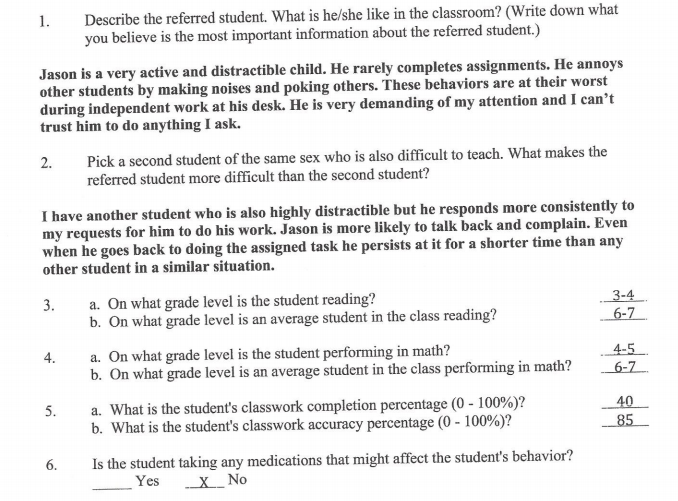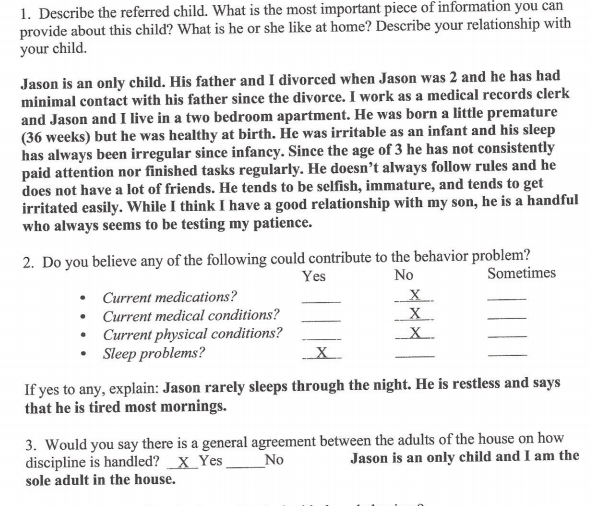Abstract
One of the most difficult responsibilities for guardians is trying to control the conduct of children who are always naughty. Many times, some children may seem unable or reluctant to adhere to instructions, collaborate with adults, or consent to any sort of restraint. Some children may not exhibit any signs of oppositional conduct. However, because of external triggers or for no obvious motive, such students may begin to develop oppositional behaviors. Therefore, parents and teachers must be cautious about detecting oppositional behaviors in children. The article below illustrates a behavioral intervention plan. Through it, Frank’s background information, recommended intervention plan, the method used, and the methodology utilized in the design are illustrated.
Introduction
Psychologists assert that there is no distinct cause utilized in foretelling if a child will exhibit oppositional conduct (Alberto & Troutman, 2009). Children with a past of mistreatment, abandonment, or distress may display oppositional conduct as a reaction to their experiences. Therefore, parents and teachers must be cautious about detecting oppositional behaviors in children. The article below focuses on Frank’s behavioral intervention plan.
In Frank’s intervention plan, cognitive behavioral therapy, CBT, will be utilized. The main purpose of the treatment approach will be to investigate and determine ambivalence based on Frank’s behavior. Essau (2013) asserts that cognitive-behavioral therapy has developed from a simple intervention plan to become a broad-based and integrative theory in many areas of the therapeutic practice. Greek Stoic philosopher was the first to mention the use of rational emotive therapy in the year 55 AD. Later on, at 121 AD, Marcus asserted that human problems are caused by their own judgments and not caused by the deities. Sanders and Wills (2005) assert that since its adoption in psychiatry, CBT has been widely studied and proved useful in the treatment of numerous psychological disorders. Currently, psychologists are conducting more than 500 studies to ascertain its effectiveness (Wilding & Milne, 2010). Numerous researches are ongoing to develop cognitive therapies used in the treatment of behavioral disorders. Psychiatrists claim that ongoing researches are aimed at evaluating the effects of cognitive therapy in public health systems.
Method
With respect to the above discussions, it is apparent that Frank needs immediate intervention. His mother should seek the help of a psychologist. The psychologist will come up with several methods of interventions to be utilized. Through this, she will be able to identify the cause of Frank’s oppositional behavior. Similarly, the psychologist will determine the best intervention approach for him (Cooper & Heron, 2007). Two methods of psychotherapy should be combined in treating Frank. With the help of a psychologist, Frank’s mother should come up with appropriate, positive childrearing skills. The skills should not be provoking for either the child or the parent. If possible, the child and the mother should participate in the training. Equally, his mother should ensure that Frank meets with his father more often. Through this, Frank will develop an emotional connection with his father just as other children do with their fathers.
Similarly, cognitive behavioral therapy should be utilized during the intervention. The therapy should be utilized as it is effective. The therapist model should comprise of three sessions integrated into brief discussions on motivational talks. The main purpose of this treatment approach is to investigate and determine ambivalence based on Frank’s behavior. Treatment will be achieved through patient-centered consultations aimed at bringing out change-related comments from the child. In the first session of the therapy, the therapists should work closely with Frank in motivating him to change. The phase depends on the appropriate utilization of self-efficacy and building inconsistencies principles between his past and present. In the second phase, the therapist should motivate him by encouraging him to refrain from negative behaviors. The phase should be accompanied by self-change statements. The main goal of this stage will be to identify and develop alteration strategies regarding the child’s oppositional behavior. In the third phase, the therapist should come up with follow-up plans for monitoring the child.
There are a number of methodologies that can be utilized in measuring the effectiveness of the intervention method chosen. The methods may include ABAB design or multiple baseline designs. For this type of research, ABAB design will be utilized.
Participant
Frank is a young boy. He lives with his mother in a two-bedroom house. His mother and father divorced when he was two years of age. Ever since then, he has had minimal contact with his father. His mother alleges that he was born a little premature. However, during his birth, he exhibited a healthy life. As an infant, Frank was irritable. His mother asserted that he does not sleep like the other children. Ever since he was three years of age, he has exhibited oppositional behavior. As such, he does not follow his mother’s instructions. Unlike his age mates, Frank prefers a solitary life.
In school, his teacher has noted his oppositional behavior. His teacher asserts that he is a very active and distractible child. Unlike other pupils, he really finishes his assignments. According to his teacher, Frank’s behaviors become worst when he does his independent task at his desk. As such, he is very demanding and only works under instructions. His teacher alleges that he cannot trust him to do anything on his own. In the past, the teacher changed his seating position in a bid to enhance his concentration. Nonetheless, the changes never changed his behavior.
Procedures
Based on the case study, Frank exhibits oppositional behavior. To assess his conduct, a number of methods were utilized. Frequency measurement is the first method utilized in the case study. The other three methods utilized to assess his behaviors are duration, interval recording, and time sampling methods.
In the case study, the targeted destructive behavior was defined in observable and measurable terms. In the video, Frank is seen humming, stamping the feet on the ground, kicking the chair, moving pencil up and down, and whispering to the child next to him. These measurable terms defined the target behavior of Frank. In the video, he was distracted from giving the exam and did not concentrate on the exam despite the teacher warning him. After attempting severally to change his behavior, the teacher sought assistance from his parent. After a thorough evaluation, the parent and the teacher developed a functional assessment informant record for evaluation. In the informant record, formulation origins, precipitants, background, and behaviors of the child are noted.
To assess Frank’s oppositional behavior, a functional assessment informant record was developed. The record comprised a number of questions that aimed at determining the parent and the teacher’s perception with respect to his behavior. The extent of Frank’s oppositional conduct can be analyzed by analyzing the form submitted by the parent and the teacher. In the questionnaire, the parent and the teacher were asked to detail their findings using open-ended questions. On the other part of the questionnaire, several questions were measured on a five-point Linker scale will be included. Linker scale is a variable measuring tool with strongly agree, agree, undecided, disagree, and strongly disagree options. The scale was very effective because it indicated the extent to which the two persons perceived Frank’s conduct.
Thereafter, the findings were summarized in an ABC observation form. The form captured the students’ names and the date the information was collected. Similarly, the form indicated the student’s behavior and the expected consequences.
Results
After a thorough evaluation, the parent and the teacher developed a functional assessment informant record for evaluation. In the informant record, formulation origins, precipitants, background, and behaviors of the child are noted. Below are the results of the evaluation. The results were collected in two forms. Frank’s mother filled one form. His teacher filled the other form.
In the teacher’s form, a number of questions were asked about Frank’s behavior. The questions wanted the teacher to illustrate his or her view about the child’s oppositional behavior. The first question sought to identify how the pupil behaves in the classroom. The second question sought to identify another student to compare his conduct with that of Frank. In the image below, the first seven questions on the teacher’s form are indicated.

With respect to problem behaviors, the teacher noted that Frank disturbed other pupils by making noise or poking them. The results also showed that he does not complete his assignments as required. According to the results, frank replies to the teacher’s questions rudely.
In the parent’s form, a number of questions were also asked about Frank’s behavior. The parent was asked to provide a detailed family background about Frank. Similarly, the parent was required to illustrate the child’s behavior at home. Through this, the parent illustrated her relation to the child. In the image below, the first three questions and their results in the parent’s form are indicated.

Discussion
Based on the above findings, it is apparent that Frank has an oppositional behavior. As such, he does not follow his mother’s instructions. Unlike his age mates, Frank prefers a solitary life. In school, his teacher has noted his oppositional behavior. His teacher asserts that he is a very active and distractible child. Unlike other pupils, he really finishes his assignments.
Given that Frank’s parents separated when he was young, he has been subjected to emotional and social challenges (Barkley & Benton, 2008). It is indicated in the questionnaire that it has been long seen Frank communicated with his father. The above implies that a quality relationship between the father and the child has not been maintained. Similarly, the results indicate that Frank’s oppositional conduct may have been caused by his parent’s failure to teach him some social skills. Equally, his mother rarely punishes him when he commits a mistake. Instead, the parent should have punished and counseled him whenever he was wrong. Similarly, the parent should teach him about the importance of exhibiting positive behaviors rather than letting the child learn on his own.
To analyze the effectiveness of the intervention methods chosen, the ABAB design will be utilized in this case study. With the design, control situations will be preceded by experimental situations (Matthys & Lochman, 2010). The experimental situations will be preceded by an extra control situation and an experimental situation. With this design, the parent and the teacher should be cautious about being able to note the changes in the child’s behavior.
Conclusion
In conclusion, it should be noted that often children might seem unable or reluctant to adhere to instructions, collaborate with adults, or consent to any sort of restraint or organization. Some children may not exhibit any signs of oppositional conduct. However, because of external triggers or for no obvious motive, such students may begin to violate instructions or be abusive. Therefore, parents and teachers must be cautious about detecting oppositional behaviors in children. If misconduct is detected, they should act swiftly to identify the root cause and means to intervene in the problem. In the case study, it is noted that ever since Frank was three years of age, he has exhibited oppositional behavior. As such, he does not follow his mother’s instructions. In school, his teacher has noted his oppositional behavior. His teacher asserts that he is a very active and distractible child. In Frank’s intervention plan, cognitive behavioral therapy, CBT, will be utilized. The main purpose of the treatment approach was to investigate and determine ambivalence based on Frank’s behavior. Treatment was achieved through patient-centered consultations aimed at bringing out change-related comments from the child.